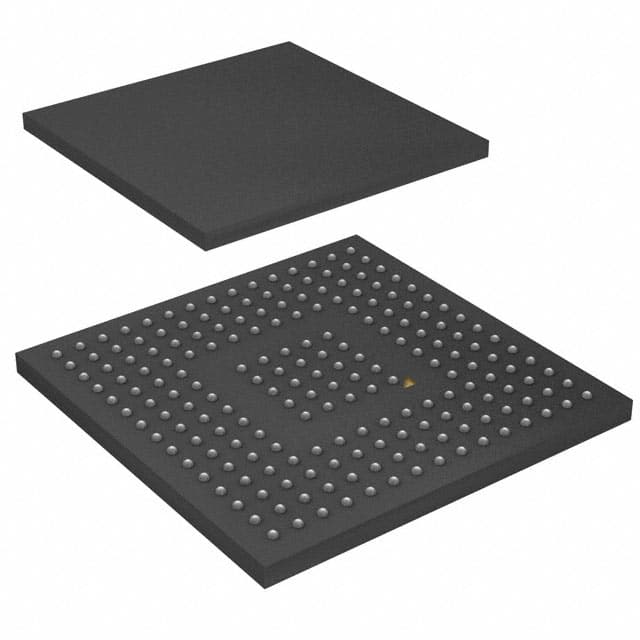STM32F745IGK6TR
Product Overview
- Category: Microcontroller
- Use: Embedded systems, Internet of Things (IoT) devices, robotics, industrial automation
- Characteristics: High-performance, low-power consumption, rich peripheral set, extensive connectivity options
- Package: LQFP (Low-profile Quad Flat Package)
- Essence: ARM Cortex-M7 core microcontroller
- Packaging/Quantity: Tape and reel, 2500 units per reel
Specifications
- Core: ARM Cortex-M7
- Clock Speed: Up to 216 MHz
- Flash Memory: 1 MB
- RAM: 320 KB
- Operating Voltage: 2.0V - 3.6V
- Digital I/O Pins: 114
- Analog Input Pins: 16
- Communication Interfaces: UART, SPI, I2C, USB, Ethernet, CAN, SDIO, SAI, HDMI-CEC, etc.
- Timers: 14 general-purpose timers, 3 advanced-control timers
- ADC Resolution: Up to 16 bits
- DMA Channels: 16
- Operating Temperature Range: -40°C to +85°C
Pin Configuration
The STM32F745IGK6TR microcontroller has a total of 176 pins. The pin configuration is as follows:
- GPIO Pins: 114 (PA0-PA15, PB0-PB15, PC0-PC15, PD0-PD15, PE0-PE15, PF0-PF15, PG0-PG15, PH0-PH15, PI0-PI15, PJ0-PJ15, PK0-PK15)
- Analog Input Pins: 16 (ADC1IN0-ADC1IN15)
- Power Supply Pins: VDD, VSS, VBAT, VREF+
- Reset Pin: NRST
- Clock Pins: OSCIN, OSCOUT
Functional Features
- High-performance ARM Cortex-M7 core for efficient processing
- Rich peripheral set for versatile applications
- Extensive connectivity options for seamless integration with other devices
- Advanced timers and DMA channels for precise timing and data transfer
- High-resolution ADC for accurate analog measurements
- Low-power consumption for energy-efficient designs
- Wide operating temperature range for harsh environments
Advantages and Disadvantages
Advantages: - Powerful processing capabilities - Versatile peripheral set - Extensive connectivity options - Efficient power management - Suitable for a wide range of applications
Disadvantages: - Complex pin configuration may require careful planning - Steeper learning curve for beginners
Working Principles
The STM32F745IGK6TR microcontroller is based on the ARM Cortex-M7 core architecture. It executes instructions stored in its flash memory to perform various tasks. The core communicates with peripherals through dedicated buses and interfaces. It can interact with external devices using communication protocols such as UART, SPI, I2C, USB, Ethernet, CAN, etc. The microcontroller's pins are configured to connect to external components and sensors, enabling input/output operations. The integrated timers and DMA channels provide precise timing and efficient data transfer. The ADC allows the microcontroller to measure analog signals accurately.
Detailed Application Field Plans
The STM32F745IGK6TR microcontroller finds applications in various fields, including:
- Embedded Systems: Used in consumer electronics, home automation, and wearable devices.
- Internet of Things (IoT): Enables connectivity and control in IoT devices.
- Robotics: Provides the processing power and connectivity required for robotic systems.
- Industrial Automation: Used in industrial control systems, motor control, and factory automation.
- Automotive: Supports automotive applications such as infotainment systems, engine control units, and advanced driver-assistance systems (ADAS).
Detailed and Complete Alternative Models
- STM32F407IGT6: Similar features with a lower clock speed and reduced flash memory.
- STM32F767ZIT6: Higher clock speed, more flash memory, and additional peripherals.
- STM32F429ZIT6: Lower clock speed, less flash memory, but lower cost.
These alternative models offer different trade-offs in terms of performance, memory, and price, allowing designers to choose the most suitable microcontroller for their specific requirements.
Word count: 525 words
Lista 10 Vanliga frågor och svar relaterade till tillämpningen av STM32F745IGK6TR i tekniska lösningar
Sure! Here are 10 common questions and answers related to the application of STM32F745IGK6TR in technical solutions:
Q: What is the STM32F745IGK6TR microcontroller used for? A: The STM32F745IGK6TR is a high-performance microcontroller commonly used in various technical solutions, including industrial automation, consumer electronics, and Internet of Things (IoT) applications.
Q: What is the maximum clock frequency supported by the STM32F745IGK6TR? A: The STM32F745IGK6TR can operate at a maximum clock frequency of 216 MHz.
Q: How much flash memory does the STM32F745IGK6TR have? A: The STM32F745IGK6TR has 1024 KB (or 1 MB) of flash memory for program storage.
Q: Can I connect external peripherals to the STM32F745IGK6TR? A: Yes, the STM32F745IGK6TR provides a wide range of peripheral interfaces, including UART, SPI, I2C, USB, Ethernet, and more, allowing you to connect external devices as needed.
Q: Does the STM32F745IGK6TR support real-time operating systems (RTOS)? A: Yes, the STM32F745IGK6TR is compatible with various RTOS options, such as FreeRTOS, enabling efficient multitasking and real-time processing capabilities.
Q: What is the power supply voltage range for the STM32F745IGK6TR? A: The STM32F745IGK6TR operates within a power supply voltage range of 2.0V to 3.6V.
Q: Can I use the STM32F745IGK6TR for low-power applications? A: Yes, the STM32F745IGK6TR offers multiple low-power modes, including Sleep, Stop, and Standby modes, allowing you to optimize power consumption based on your application requirements.
Q: Does the STM32F745IGK6TR have built-in security features? A: Yes, the STM32F745IGK6TR includes hardware cryptographic accelerators, secure boot, and memory protection units (MPUs) to enhance the security of your applications.
Q: Is the STM32F745IGK6TR supported by a development ecosystem? A: Yes, STMicroelectronics provides a comprehensive development ecosystem, including software libraries, development boards, integrated development environments (IDEs), and online resources to support the STM32F745IGK6TR.
Q: Can I program the STM32F745IGK6TR using C/C++? A: Yes, the STM32F745IGK6TR can be programmed using C/C++ programming languages, and various development tools, such as STM32CubeIDE or Keil MDK, can be used for software development.
Please note that these answers are general and may vary depending on specific implementation details and requirements.


